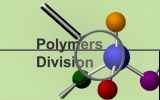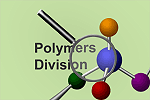Pattern Transfer and Stability
|
| |
Introduction
|
 |
|
Nanoimprint lithography (NIL) has demonstrated the ability
to pattern features as small as 5 nm
Widespread use of NIL as a robust nanofabrication method
requires well-controlled pattern fidelity
The stability of nanoscale patterns is critical to the use
of NIL to pattern functional materials
|
 |
| Examples of Nanoimprint Lithography pattern
resolution |
| |
Experimental Approach
|
 |
| |
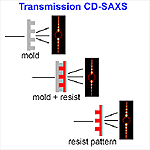 Transmission
CD-SAXS Transmission
CD-SAXS
Pattern shape extracted with sub-nm resolution by modeling
diffraction pattern
X-rays can penetrate both hard mold and soft resist film
Completely characterize mold shape, fill of resist into
mold, & final resist pattern
|
|
Both mold & imprint diffraction patterns are well fit
(red) with a trapezoidal cross section for the parallel lines
and spaces
Silicon oxide mold spaces become PMMA lines
Side wall angles are within experimental uncertainty Width
of imprinted PMMA lines contracts by » 10 nm
|
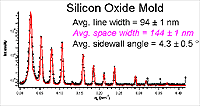
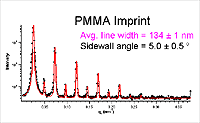
|
| |
Results
|
 |
| Imprinted Pattern Stability |
Anneal imprinted PMMA lines at Tg + 25 °C
Monitor dimensional changes with CD-SAXS |
| |
Pattern quality degrades with annealing time
3-D line shape consistent with “slumping” of trapezoid
cross section (broadened in width, increase side wall angle,
reduced height) |
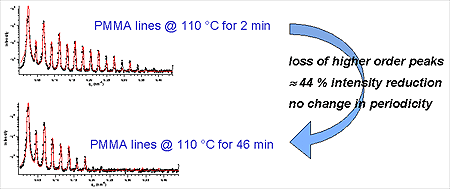 |
| |
 |
| |
 |
| |
 |
| |
NIST Contributors
|
 |
Christopher Soles*
Ronald Jones
Tengjiao Hu
Wen-li Wu
Eric Lin
Stephanie Hooker
Colm Flannery |
| |
Collaborators:
|
 |
Diego Casa (1)
Rainer Kolb (2)
Alexei Sokolov (3)
Stella Pang (4)
Ron Reano (4)
C. Grant Willson (5)
Steve Johnson (5)
Martha Sanchez (6)
Larry Koecher (7)
Doug Resnick (8)
Kevin Nordquist (8) |
| |
| |
| |
| |
| |


